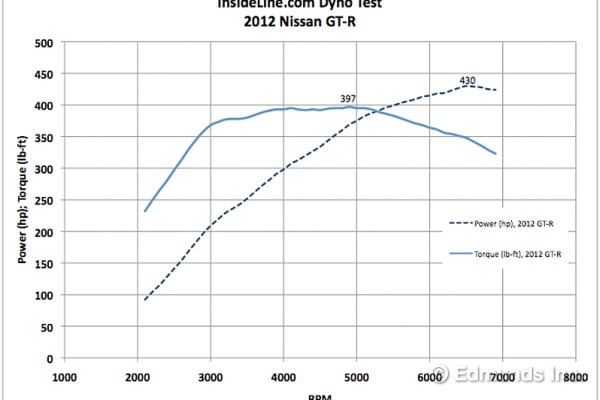At a glance, the 2012 Nissan GT-R is a dead ringer for the outgoing model. Our full test of the 2012 GT-R suggests otherwise. So do our dyno results.

When rumblings of the 2009 Nissan GT-R's performance first came about in late 2007, the armchair quarterbacking that ensued was immediate and intense. Every keyboard warrior in North America manned a battle station in their parents' basement, some proclaiming the GT-R a cheater, a fake, even a failure.
Among the speculation were claims that the 2009 GT-R's 480-hp output was underrated. Our dyno test results suggested otherwise, as the 480-hp Nissan produced exactly the same peak power as a 480-hp Porsche 911 Turbo. If Nissan was lying about its claimed output then so was Porsche.
Fast forward to today. Nissan pegs the 2012 GT-R's output at 530 horsepower, an increase of 50 horsepower over the 2009 model (45 more than the 485-hp 2010 GT-R). If that's not a good enough excuse to make another trip to the dyno, then one doesn't exist.

Being an all wheel-drive car, we couldn't test the 2012 GT-R on our usual Dynojet chassis dyno. Instead we ventured to GMG Racing in Santa Ana, California, which has a Mustang 4WD dyno situated in a soundproof cell. This is the very same dyno, in fact, that we used in the aforementioned dyno test of the JDM 2009 GT-R.
After seven nearly identical runs on the dyno with the 2012 GT-R, we called it a day. Here's the final, stabilized result:

Maximum torque of 397 lb-ft arrived at 4900 rpm, while peak power of 430 horsepower was observed at 6500 rpm. The GT-R's twin-turbo 3.8-liter V6 is a husky thing, churning out more than 350 lb-ft to the wheels from 2900 to 6400 rpm.
Time for some perspective. GMG has tested several GT-Rs on this dyno, and here's how the 2012 GT-R compares to an average box-stock 2009 GT-R plucked from their library:


The new car diverges from the 2009 model from as low as 2600 rpm and never looks back. Peak torque rises by 17 lb-ft from the 2009 GT-R's 380 lb-ft while power swells by 44 horsepower over the old car's maximum of 386 horsepower.
So the gains are real, and they span nearly the entire rev range. According to Nissan the improvements stem from reduced exhaust backpressure, revised cam mapping, improved cooling flow through the intercoolers and an increase in boost pressure.
Oddly enough, in our testing the 2012 GT-R ran no more boost than the 2009 car (see chart; above right). The reason is likely octane. More accurately, a lack of it. California's 91 octane "premium" fuel limits the aggressiveness of the car's boost and ignition calibrations. Put real fuel like the crazy stuff you Midwesterners get at the pump (93 or -- joy of joys -- 94 octane) in the 2012 GT-R and expect to see the boost and output increase further.
Last thing to keep in mind while perusing these dyno results -- Mustang dynos generally produce lower absolute numbers than Dynojets or Dynapack dynos. Comparing results across dynos is like comparing apples to kumquats. Focus on the gains.




